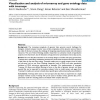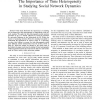656 search results - page 51 / 132 » Brain Complexity: Analysis, Models and Limits of Understandi... |
CI
2000
13 years 8 months ago
2000
Kowalski and Sergot's Event Calculus (EC) is a simple temporal formalism that, given a set of event occurrences, derives the maximal validity intervals (MVIs) over which prop...
ACSC
2006
IEEE
14 years 2 months ago
2006
IEEE
This paper describes our experience when applying formal methods in the design of the tourist information system TIP, which presents context-sensitive information to mobile users ...
WSC
1997
13 years 10 months ago
1997
This tutorial introduces the MODSIM III language, showing how its simulation "world view" together with its object-oriented architecture and built in graphics contribute...
BMCBI
2004
13 years 8 months ago
2004
Background: The increasing complexity of genomic data presents several challenges for biologists. Limited computer monitor views of data complexity and the dynamic nature of data ...
HICSS
2011
IEEE
13 years 13 days ago
2011
IEEE
—This study illustrates the importance of assessing and accounting for time heterogeneity in longitudinal social network analysis. We apply the time heterogeneity model selection...


